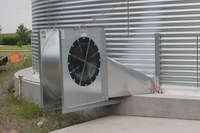NDSU offers advice for soybean harvest and drying
(Click the image below to view a high-resolution image that can be downloaded)
Harvest timing and soybean moisture content can have a huge impact on soybean shatter losses, according to North Dakota State University Extension agricultural engineer Ken Hellevang.“There is considerable variation this year due to the challenging spring, variation in rainfall, planting date, maturity rating and growing degree days, so it is important to check each field,” says Hellevang. “There may also be considerable variation within a field.”
Soybean moisture content in the field will fluctuate depending on drying conditions and air humidity. Moisture content can increase by several points with an overnight dew or rain event, and it can decrease by several points during a day with low humidity and windy conditions.
“Field losses, splits and cracked seed coats increase as moisture content decreases,” Hellevang says. “Shatter losses have been shown to increase significantly when seed moisture falls below 11% and when mature beans undergo multiple wetting and drying cycles.”
He recommends that producers try to harvest as much of their crop as possible before the moisture level falls below 11% to 12%. Producers will receive the best price for their soybeans when the moisture content is 13%. Prices will be discounted for beans at moisture contents exceeding about 13%, and beans are prone to storage problems at higher moisture contents.
Because harvest losses increase dramatically when the moisture content is below 11%, harvesting during high humidity or damp conditions may reduce shatter loss, according to Hellevang.
Soybeans at 11% to 12% moisture have similar storage characteristics as wheat or corn at about 13.5% to 14.5% moisture, and 13% moisture soybeans might be expected to store the same way as 15.5% moisture wheat and corn. The 13% moisture content is adequate for winter storage, but for summer storage, the moisture content should be closer to 11%.
Soybean moisture variation may lead to storage losses. Operating an aeration fan will help move moisture from wet beans to drier beans. Air going past wet beans picks up moisture, and that moisture will transfer to drier beans as the air goes past them. Moisture movement will be minimal without aeration airflow. Hellevang suggests initially running the fan longer than is required to cool the grain to even out the moisture content. The moisture will not be all the same, but it should become more uniform.
Natural air drying with an adequate airflow rate of at least 1.0 cubic feet of air per minute, per bushel of stored grain is feasible during early October, but as average air temperatures drop below 40 degrees Fahrenheit, natural air drying becomes inefficient and not economical. Adding heat causes the beans on the bottom of the bin to dry to a lower moisture content, and it would increase drying speed only slightly.
Hellevang recommends cooling the soybeans to between 20 and 30 degrees Fahrenheit for winter storage and completing the natural air drying in the spring. Start drying in the spring when outdoor temperatures are averaging about 40 degrees.
Soybeans can be dried in a high-temperature dryer, but the dryer temperature needs to be limited to minimize damage to the beans. Refer to the manufacturer’s recommendations for maximum drying temperature. Typically, the maximum drying temperature for nonfood soybeans is about 130 degrees Fahrenheit. Even at that temperature, some skins and beans will be cracked. He recommends monitoring the soybean seeds coming from the dryer and managing the dryer temperature based on the amount of damage occurring.
Keep the air relative humidity above 40% to minimize cracking of food grade or seed beans. Roughly, with each 20-degree increase in drying temperature, the air relative humidity is reduced to one-half, Hellevang notes. Air at 40 degrees and 80% relative humidity will have a relative humidity of about 40% when heated to 60 degrees. Therefore, very little heat should be added in a column dryer when drying seed or food grade beans. Food grade soybeans and seed beans must not have damage to the seed coat, so natural-air or low-temperature drying is the preferred drying method, Hellevang says.
Hellevang also warns of the risk of fires when drying soybeans. Soybean pods and other trash can accumulate in the dryer and become combustible. He has this advice to reduce the risk of fires:
- Assure that trash does not accumulate in the dryer.
- Assure that the soybeans continue to flow in all sections of the dryer.
- Monitor the dryer continuously.
- Clean the dryer frequently to reduce the potential for debris to combust.
Cool the soybeans to 20 to 25 degrees for winter storage. Hellevang supports using temperature cables to assist with monitoring the soybeans, but technology does not replace management. He still recommends monitoring the soybean moisture content, inspecting for insects and observing soybean quality.
Remember safety when working around grain. Protect yourself from grain dust with an N95 mask. Do not go into a grain bin while the grain is moving. It only takes a couple seconds to become helpless in flowing grain. Use the lock-out tag-out system to assure that you do not get hurt while working on grain drying and handling equipment.
For more information on soybean drying and storage, search online for NDSU grain drying and storage.
NDSU Agriculture Communication – Sept. 26, 2023
Source: Ken Hellevang, 701-231-7243, kenneth.hellevang@ndsu.edu
Editor: Elizabeth Cronin, 701-231-7881, elizabeth.cronin@ndsu.edu


